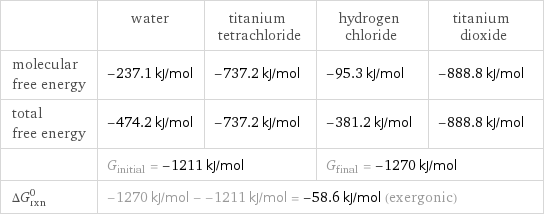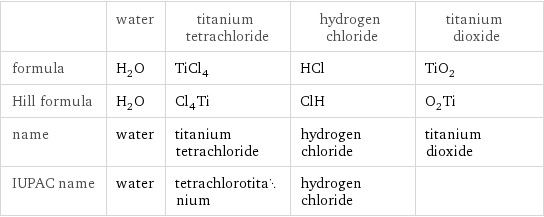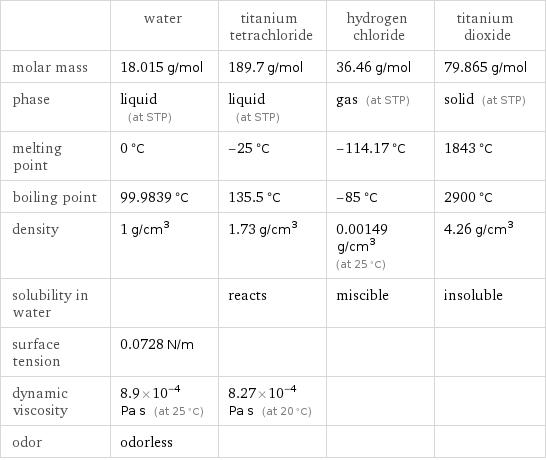Input interpretation

H_2O water + TiCl_4 titanium tetrachloride ⟶ HCl hydrogen chloride + TiO_2 titanium dioxide
Balanced equation

Balance the chemical equation algebraically: H_2O + TiCl_4 ⟶ HCl + TiO_2 Add stoichiometric coefficients, c_i, to the reactants and products: c_1 H_2O + c_2 TiCl_4 ⟶ c_3 HCl + c_4 TiO_2 Set the number of atoms in the reactants equal to the number of atoms in the products for H, O, Cl and Ti: H: | 2 c_1 = c_3 O: | c_1 = 2 c_4 Cl: | 4 c_2 = c_3 Ti: | c_2 = c_4 Since the coefficients are relative quantities and underdetermined, choose a coefficient to set arbitrarily. To keep the coefficients small, the arbitrary value is ordinarily one. For instance, set c_2 = 1 and solve the system of equations for the remaining coefficients: c_1 = 2 c_2 = 1 c_3 = 4 c_4 = 1 Substitute the coefficients into the chemical reaction to obtain the balanced equation: Answer: | | 2 H_2O + TiCl_4 ⟶ 4 HCl + TiO_2
Structures

+ ⟶ +
Names

water + titanium tetrachloride ⟶ hydrogen chloride + titanium dioxide
Reaction thermodynamics
Gibbs free energy

| water | titanium tetrachloride | hydrogen chloride | titanium dioxide molecular free energy | -237.1 kJ/mol | -737.2 kJ/mol | -95.3 kJ/mol | -888.8 kJ/mol total free energy | -474.2 kJ/mol | -737.2 kJ/mol | -381.2 kJ/mol | -888.8 kJ/mol | G_initial = -1211 kJ/mol | | G_final = -1270 kJ/mol | ΔG_rxn^0 | -1270 kJ/mol - -1211 kJ/mol = -58.6 kJ/mol (exergonic) | | |
Equilibrium constant
![Construct the equilibrium constant, K, expression for: H_2O + TiCl_4 ⟶ HCl + TiO_2 Plan: • Balance the chemical equation. • Determine the stoichiometric numbers. • Assemble the activity expression for each chemical species. • Use the activity expressions to build the equilibrium constant expression. Write the balanced chemical equation: 2 H_2O + TiCl_4 ⟶ 4 HCl + TiO_2 Assign stoichiometric numbers, ν_i, using the stoichiometric coefficients, c_i, from the balanced chemical equation in the following manner: ν_i = -c_i for reactants and ν_i = c_i for products: chemical species | c_i | ν_i H_2O | 2 | -2 TiCl_4 | 1 | -1 HCl | 4 | 4 TiO_2 | 1 | 1 Assemble the activity expressions accounting for the state of matter and ν_i: chemical species | c_i | ν_i | activity expression H_2O | 2 | -2 | ([H2O])^(-2) TiCl_4 | 1 | -1 | ([TiCl4])^(-1) HCl | 4 | 4 | ([HCl])^4 TiO_2 | 1 | 1 | [TiO2] The equilibrium constant symbol in the concentration basis is: K_c Mulitply the activity expressions to arrive at the K_c expression: Answer: | | K_c = ([H2O])^(-2) ([TiCl4])^(-1) ([HCl])^4 [TiO2] = (([HCl])^4 [TiO2])/(([H2O])^2 [TiCl4])](../image_source/445aa2106e328927efcf8db9cfdaf7c1.png)
Construct the equilibrium constant, K, expression for: H_2O + TiCl_4 ⟶ HCl + TiO_2 Plan: • Balance the chemical equation. • Determine the stoichiometric numbers. • Assemble the activity expression for each chemical species. • Use the activity expressions to build the equilibrium constant expression. Write the balanced chemical equation: 2 H_2O + TiCl_4 ⟶ 4 HCl + TiO_2 Assign stoichiometric numbers, ν_i, using the stoichiometric coefficients, c_i, from the balanced chemical equation in the following manner: ν_i = -c_i for reactants and ν_i = c_i for products: chemical species | c_i | ν_i H_2O | 2 | -2 TiCl_4 | 1 | -1 HCl | 4 | 4 TiO_2 | 1 | 1 Assemble the activity expressions accounting for the state of matter and ν_i: chemical species | c_i | ν_i | activity expression H_2O | 2 | -2 | ([H2O])^(-2) TiCl_4 | 1 | -1 | ([TiCl4])^(-1) HCl | 4 | 4 | ([HCl])^4 TiO_2 | 1 | 1 | [TiO2] The equilibrium constant symbol in the concentration basis is: K_c Mulitply the activity expressions to arrive at the K_c expression: Answer: | | K_c = ([H2O])^(-2) ([TiCl4])^(-1) ([HCl])^4 [TiO2] = (([HCl])^4 [TiO2])/(([H2O])^2 [TiCl4])
Rate of reaction
![Construct the rate of reaction expression for: H_2O + TiCl_4 ⟶ HCl + TiO_2 Plan: • Balance the chemical equation. • Determine the stoichiometric numbers. • Assemble the rate term for each chemical species. • Write the rate of reaction expression. Write the balanced chemical equation: 2 H_2O + TiCl_4 ⟶ 4 HCl + TiO_2 Assign stoichiometric numbers, ν_i, using the stoichiometric coefficients, c_i, from the balanced chemical equation in the following manner: ν_i = -c_i for reactants and ν_i = c_i for products: chemical species | c_i | ν_i H_2O | 2 | -2 TiCl_4 | 1 | -1 HCl | 4 | 4 TiO_2 | 1 | 1 The rate term for each chemical species, B_i, is 1/ν_i(Δ[B_i])/(Δt) where [B_i] is the amount concentration and t is time: chemical species | c_i | ν_i | rate term H_2O | 2 | -2 | -1/2 (Δ[H2O])/(Δt) TiCl_4 | 1 | -1 | -(Δ[TiCl4])/(Δt) HCl | 4 | 4 | 1/4 (Δ[HCl])/(Δt) TiO_2 | 1 | 1 | (Δ[TiO2])/(Δt) (for infinitesimal rate of change, replace Δ with d) Set the rate terms equal to each other to arrive at the rate expression: Answer: | | rate = -1/2 (Δ[H2O])/(Δt) = -(Δ[TiCl4])/(Δt) = 1/4 (Δ[HCl])/(Δt) = (Δ[TiO2])/(Δt) (assuming constant volume and no accumulation of intermediates or side products)](../image_source/4788af40dfc801f517239cc418e8837c.png)
Construct the rate of reaction expression for: H_2O + TiCl_4 ⟶ HCl + TiO_2 Plan: • Balance the chemical equation. • Determine the stoichiometric numbers. • Assemble the rate term for each chemical species. • Write the rate of reaction expression. Write the balanced chemical equation: 2 H_2O + TiCl_4 ⟶ 4 HCl + TiO_2 Assign stoichiometric numbers, ν_i, using the stoichiometric coefficients, c_i, from the balanced chemical equation in the following manner: ν_i = -c_i for reactants and ν_i = c_i for products: chemical species | c_i | ν_i H_2O | 2 | -2 TiCl_4 | 1 | -1 HCl | 4 | 4 TiO_2 | 1 | 1 The rate term for each chemical species, B_i, is 1/ν_i(Δ[B_i])/(Δt) where [B_i] is the amount concentration and t is time: chemical species | c_i | ν_i | rate term H_2O | 2 | -2 | -1/2 (Δ[H2O])/(Δt) TiCl_4 | 1 | -1 | -(Δ[TiCl4])/(Δt) HCl | 4 | 4 | 1/4 (Δ[HCl])/(Δt) TiO_2 | 1 | 1 | (Δ[TiO2])/(Δt) (for infinitesimal rate of change, replace Δ with d) Set the rate terms equal to each other to arrive at the rate expression: Answer: | | rate = -1/2 (Δ[H2O])/(Δt) = -(Δ[TiCl4])/(Δt) = 1/4 (Δ[HCl])/(Δt) = (Δ[TiO2])/(Δt) (assuming constant volume and no accumulation of intermediates or side products)
Chemical names and formulas

| water | titanium tetrachloride | hydrogen chloride | titanium dioxide formula | H_2O | TiCl_4 | HCl | TiO_2 Hill formula | H_2O | Cl_4Ti | ClH | O_2Ti name | water | titanium tetrachloride | hydrogen chloride | titanium dioxide IUPAC name | water | tetrachlorotitanium | hydrogen chloride |
Substance properties

| water | titanium tetrachloride | hydrogen chloride | titanium dioxide molar mass | 18.015 g/mol | 189.7 g/mol | 36.46 g/mol | 79.865 g/mol phase | liquid (at STP) | liquid (at STP) | gas (at STP) | solid (at STP) melting point | 0 °C | -25 °C | -114.17 °C | 1843 °C boiling point | 99.9839 °C | 135.5 °C | -85 °C | 2900 °C density | 1 g/cm^3 | 1.73 g/cm^3 | 0.00149 g/cm^3 (at 25 °C) | 4.26 g/cm^3 solubility in water | | reacts | miscible | insoluble surface tension | 0.0728 N/m | | | dynamic viscosity | 8.9×10^-4 Pa s (at 25 °C) | 8.27×10^-4 Pa s (at 20 °C) | | odor | odorless | | |
Units
